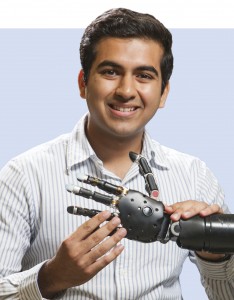 When junior Farhan Damani arrived as a freshman at Johns Hopkins, he thought he wanted to study philosophy and political science. But a computer class introduced him to the beauty of programming. “It combined all the elements of philosophy,” he says. “I fell in love with it.”
When junior Farhan Damani arrived as a freshman at Johns Hopkins, he thought he wanted to study philosophy and political science. But a computer class introduced him to the beauty of programming. “It combined all the elements of philosophy,” he says. “I fell in love with it.”
Last summer, Damani capitalized on his newfound passion for computer programming by working as one of the Whiting School’s first SPUR interns (short for the APL/WSE Summer Program in Undergraduate Research), funded through the generosity of trustee Heather Murren, A&S ’88, P ’17, and her husband, Jim Murren P ’17. The new program provided paid internships for 11 undergraduates who were hand-picked to work with faculty mentors at the Applied Physics Laboratory in Laurel, Maryland, on projects that included computer vision, secure mobile communications, and prosthetics.
Damani devoted his energies to prosthetics, working with Kapil Katyal, lead software engineer on the Modular Prosthetic Limb, a $150 million, seven-year effort by APL and the Defense Advanced Research Projects Agency to build what has been touted as the world’s most sophisticated bionic arm—largely because it is thought-controlled. Advances with this modular limb have the potential to revolutionize rehabilitation of para- and quadriplegic patients.
Damani’s task was to work on algorithms to help with the development of a stable grasp on arbitrary 3-D objects. The 4.5-kilogram modular limb operates much like a real hand, using more than 100 sensors, 26 joints, 17 motors, and a tiny computer. Researchers have been working out kinks with the grasp, trying to refine the limb’s ability to pick up a coffee cup, say, versus a pencil. “With grasping, it turns out that you use a lot of pre-knowledge about the shape of the object,” says Katyal. “For us, that turns into an incredibly complicated mathematical model.”
Over the 10-week internship, Damani worked side by side with Katyal evaluating existing grasp planning algorithms, computing valid grasps, and writing programs that improve the modular limb’s ability to calculate the most feasible grasp for an arbitrary object.
Damani expects to present results of his summer work at an academic conference or in a journal. His algorithm will be tested in a clinical setting. He now is working as
a temp-on-call at APL to continue the research during the academic year. “This internship was really different than school,” he says. “Every day I would come here, and the possibilities were endless. There were 15 different directions that we could have moved in, but in the end, I was able to decide… that’s a pretty sweet deal.”




